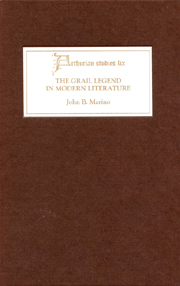Book contents
2 - Christian vs. Pagan: Origins and Culture Wars
Published online by Cambridge University Press: 12 September 2012
Summary
The nineteenth century saw a revival of interest in the Arthurian legend, and an inquiry into the origin of the legend. Why at this time? The nineteenth century was an age of science, and the Arthurian world belongs to a medieval past which put faith in an untestable spiritual realm. Strange beasts and sorcerers walk the landscape of medieval texts. Superstitious rituals occupy lives. What place can such a world have in an era of scientific enlightenment? One reason for the revival is that at times like this, paradoxically, preoccupations with the spiritual realm surface. The latter part of the eighteenth century, the age of enlightenment by rationalism, saw the rise of the Gothic novel and the movement referred to as “Romanticism” amid the Industrial Revolution. These movements looked back to the medieval world for mystery and exotic occurrences. In the introduction to The Oxford Book of Gothic Tales, Chris Baldrick explains the anti-Gothic impulse of Gothic fiction, which calls up the folklore of a medieval past in order to reveal that it is no more than the superstition of a papist age (xiii–iv). But even though that superstition is considered silly, it is still fascinating. Medieval literature had something to offer the eighteenth and nineteenth centuries, which needed the otherworldliness of superstitious stories to counterbalance the rationalism of the Enlightenment. In American Gothic: Imagination and Reason in Nineteenth-Century Fiction, Donald A. Ringe explains how a heavy emphasis on realism in American fiction at this time provoked the Gothic genre in America, which filled a need for escape into the realm of the imagination (8).
- Type
- Chapter
- Information
- The Grail Legend in Modern Literature , pp. 28 - 81Publisher: Boydell & BrewerPrint publication year: 2004



